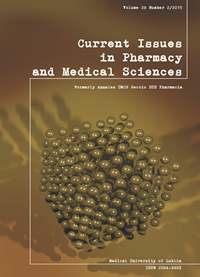Retention behavior of selected alkaloids in Reversed Phase micellar chromatographic systems
DOI:
https://doi.org/10.1515/cipms-2015-0058Keywords:
alkaloids, micellar chromatography, system efficiency, HPLC, SDSAbstract
In this work, the effects of sodium dodecyl sulfate (SDS) concentrations on retention, separation selectivity, peak shapes and systems efficiency were investigated. Herein, the retention data for 11 alkaloids were determined on an RP18 silica column with mobile phases containing methanol as organic modifier, with acetate buffer at pH 3.5, and, subsequently, with the addition of sodium dodecyl sulfate (SDS). The results of this study indicate that the retention of alkaloids decreases with the increase of SDS concentration in the mobile phase. The increase of SDS concentration, however, leads to the significantly improvement of peak symmetry and the increase of theoretical plate number in all cases. The best system efficiency for most of the investigated alkaloids was obtained in a mobile phase containing 0.1M SDS, while most symmetrical peaks were obtained through the addition of 0.3M of SDS to the mobile phase.References
1. Agrawal N. et al.: Determination of Paroxetine in Blood and Urine Using Micellar Liquid Chromatography with Electrochemical Detection. J. Chromatogr. Sci., 52, 1217, 2014.
2. Belal F. et al.: Micellar HPLC and Derivative Spectrophotometric Methods for the Simultaneous Determination of Fluconazole and Tinidazole in Pharmaceuticals and Biological Fluids. J. Chromatogr. Sci., 52, 298, 2014.
3. Carda-Broch S. et al.: Analysis of Urine Samples Containing Cardiovascular Drugs by Micellar Liquid Chromatography with Fluorimetric Detection. J. Chromatogr. Sci., 37, 93, 1999.
4. Enga A.T.W., Henga M.Y., Ong E.S.: Evaluation of surfactant assisted pressurized liquid extraction for the determination of glycyrrhizin and ephedrine in medicinal plants. Anal. Chim. Acta, 583, 289, 2007.
5. Evans R.L., Siitonen P.H.: Determination of Caffeine and Sympathomimetic Alkaloids in Weight Loss Supplements by High-Performance Liquid Chromatography. J. Chromatogr. Sci., 46, 61, 2008.
6. Gil-Agustí M. et al.: Use of Micellar Mobile Phases for the Chromato-graphic Determination of Clorazepate, Diazepam, and Diltiazem in Pharmaceuticals, J. Chromatogr. Sci., 38, 521, 2000.
7. Hadjmohammadi M.R., Kamel K.: Optimization of the Separation of Quinolines in Micellar Liquid Chromatography by Experimental Design and Regression Models. Chin. J. Chem., 26 2197, 2008.
8. Hammouda M.E.A. et al.: Simultaneous Determination of Enalapril and Hydrochlorothiazide in Pharmaceutical Preparations Using Microemulsion Liquid Chromatography. J. Chromatogr. Sci., 53, 90, 2015.
9. Jia C.-P., Feng F.: Optimization of the Separation and Determination of Nitidine and Chelerythrine in Zanthoxylum nitidum by High-Performance Liquid Chromatography with Fluorescence Detection. J. Chromatogr. Sci., 52, 164, 2014.
10. Martín L. et al.: Fluorescence quenching of β –carboline alkaloids in micellar media. A study to select the adequate surfactant to use in analytical techniques. Luminescence, 20, 152, 2005.
11. Rizk M.S. et al.: Development and Validation of a Stability-Indicating Micellar Liquid Chromatographic Method for the Determination of Timolol Maleate in the Presence of Its Degradation Products. doi:10.1093/chromsci/bmu075
12. Ruiz-Angel M.J. et al.: Improvement of Peak Shape and Separation Performance of b-Blockers in Conventional Reversed-Phase Columns Using Solvent Modifiers. J. Chromatogr. Sci., 41, 350, 2003.
13. Venugopal K. et al.: Development and Validation of an Ion-Pairing RP-HPLC Method for the Estimation of Gatifloxacin in Bulk and Formulations. J. Chromatogr. Sci., 45, 220, 2007.
Downloads
Published
Issue
Section
License
Copyright (c) 2015 Authors

This work is licensed under a Creative Commons Attribution-NonCommercial-NoDerivatives 3.0 Unported License.


